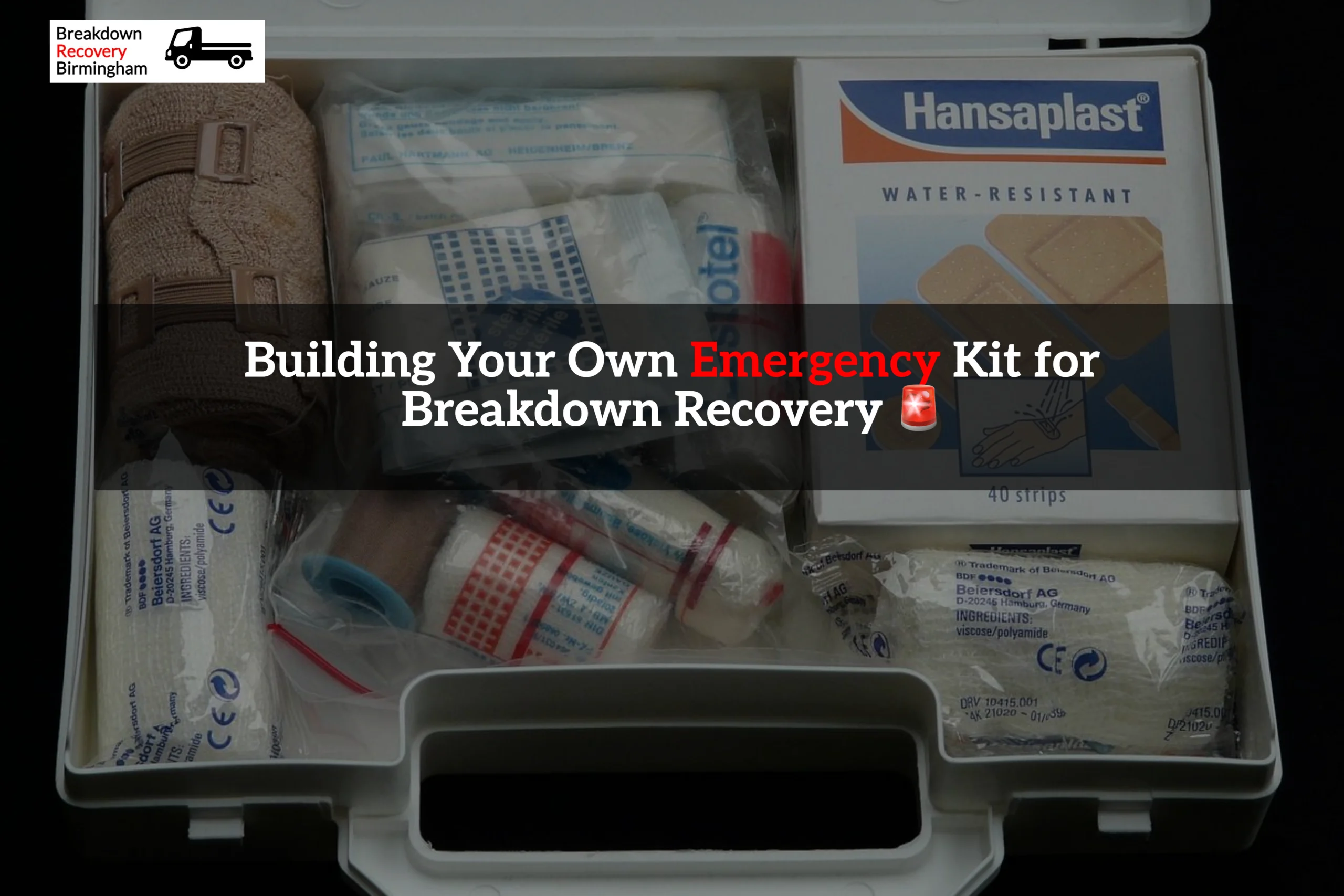Emergencies can happen at any time, and it’s crucial to be prepared, especially when you’re on the road. One way to ensure your safety during unforeseen circumstances is by having a well-equipped emergency kit in your vehicle. Whether it’s a flat tire, a mechanical issue, or any other roadside emergency, having the right supplies can make a significant difference in how you handle the situation.
Table of Contents
| Category | Items |
|---|---|
| First Aid Kit | Bandages, antiseptic wipes, pain relievers, scissors, tweezers. |
| Tools | Screwdrivers, adjustable wrench, pliers, tire pressure gauge, multipurpose tool, duct tape, jumper cables. |
| Vehicle-Specific | Spare tire, jack, lug wrench, tire inflator, tow strap, car manual. |
| Safety and Visibility | Flashlight, reflective triangles/flares, high-visibility vest, emergency whistle. |
| Fluids | Engine oil, brake fluid, transmission fluid, coolant, windshield washer fluid. |
| Electronics | Portable phone charger, emergency radio, spare fuses. |
| Comfort and Documentation | Blanket, non-perishable snacks, bottled water, important contact numbers, copies of registration and insurance. |
| Miscellaneous | Cash, wipes/hand sanitizer, trash bags, zip ties. |
| Personal | Medications, personal hygiene items, copies of ID. |
| Emergency Tools | Window breaker and seatbelt cutter. |
| Roadside Assistance | Membership card and contact details. |
What are the Essential Items for a Car Emergency Kit?
Must-Have Supplies for Your Car Emergency Kit
When assembling your car emergency kit, it’s important to include essential items that can assist you in various emergency situations. These may include a first aid kit, jumper cables, a flashlight with extra batteries, a multi-tool, a fire extinguisher, a reflective triangle or road flares, and a portable phone charger. Additionally, having a basic toolkit and a spare tire can also be beneficial.
Creating the Ultimate Car Emergency Kit Checklist
To ensure that you have all the necessary items in your car emergency kit, it’s helpful to create a checklist. This checklist should include items such as a fully stocked first aid kit, a set of jumper cables, a flashlight, a multi-tool, a fire extinguisher, a reflective triangle or road flares, a portable phone charger, a basic toolkit, a spare tire, and additional items like a blanket, water, and non-perishable snacks.
Key Emergency Items to Include in Your Vehicle
Equipping your vehicle with key emergency items is essential for dealing with unexpected breakdowns or emergencies. Some of these items include a tow rope, a handheld radio, a waterproof and weather-resistant emergency blanket, and a supply of water and non-perishable food. Additionally, having a can of tire sealant or a tire plug kit can be useful in case of a flat tire.
How to Build an Emergency Car Kit for Roadside Emergencies?
Tips for Building a Well-Equipped Car Survival Kit
When building a car survival kit, it’s important to consider the specific needs of your vehicle and the potential emergencies you may encounter. Ensure that your kit includes items such as a well-stocked first aid kit, a flashlight, extra batteries, a multi-tool, a portable phone charger, a reflective triangle, and a basic toolkit. Additionally, having a supply of non-perishable food and water is crucial for situations where you may be stranded for an extended period of time.
What to Put in Your Emergency Car Kit
When assembling your emergency car kit, it’s important to include items that can assist you in various roadside emergencies. Some essential items to include are jumper cables, a fire extinguisher, a tow rope, a reflective vest, a tire pressure gauge, a tire inflator, and a window breaker and seatbelt cutter tool. These items can help you address a range of emergency situations, from a dead battery to a vehicle collision.
Preparing a Winter Car Emergency Kit
In colder climates, preparing a winter car emergency kit is essential to ensure your safety during inclement weather and potential vehicle issues. Your winter emergency kit should include items such as a portable shovel, ice scraper, windshield de-icer, rock salt or sand for traction, extra warm clothing and blankets, and high-energy, non-perishable snacks. Additionally, having a supply of cat litter can provide traction if your vehicle gets stuck in snow or ice.
Why is Having a First Aid Kit Important in Your Vehicle?
Importance of a First Aid Kit in Your Car Emergency Supplies
One of the most crucial items to include in your car emergency supplies is a well-stocked first aid kit. In the event of an emergency, having access to essential first aid supplies can make a significant difference in providing immediate medical assistance until professional help arrives. The first aid kit should include items such as bandages, gauze, adhesive tape, antiseptic wipes, pain relievers, scissors, tweezers, and gloves.
Inclusion of Essential First Aid Supplies in Your Emergency Kit
When assembling your emergency kit, it’s important to include essential first aid supplies to address minor injuries and medical emergencies. Some key items to include in your first aid kit are adhesive bandages of various sizes, sterile gauze pads, antiseptic wipes, adhesive tape, tweezers, scissors, instant cold packs, and a first aid manual. Additionally, any personal medications should be included in the first aid kit if needed.
Benefits of Being Prepared with a Car First Aid Kit
Being prepared with a car first aid kit offers numerous benefits, including the ability to address minor injuries and medical emergencies on the spot. Additionally, having a first aid kit can provide peace of mind and confidence, knowing that you’re equipped to handle unexpected health issues while on the road. It’s essential to periodically check and restock your first aid kit to ensure that all supplies are up to date and in good condition.
How to Prepare for Roadside Emergencies with an Emergency Kit?
Guide to Safely Building an Emergency Kit for Your Vehicle
When building an emergency kit for your vehicle, it’s important to do so safely and responsibly. Ensure that all items in the kit are properly secured and organized to prevent any potential hazards while driving. Additionally, it’s crucial to familiarize yourself with the location of each item in the kit and how to use them effectively in the event of an emergency.
What Supplies to Carry for Your Roadside Emergency Kit
Carrying the right supplies in your roadside emergency kit is essential for ensuring your safety and preparedness. Some essential supplies to carry include a well-stocked first aid kit, jumper cables, a flashlight with extra batteries, a multi-tool, a fire extinguisher, a supply of non-perishable food and water, and a basic toolkit. Also, having a reflective vest and a roadside emergency warning triangle can enhance your visibility and safety during a roadside emergency.
Ensuring Waterproof and Weather-Resistant Items in Your Car Emergency Kit
It’s crucial to ensure that the items in your car emergency kit are waterproof and weather-resistant to maintain their effectiveness in various environmental conditions. Store items such as matches, lighters, and electronic devices in a waterproof container to prevent damage. Additionally, consider packing extra clothing and blankets in a waterproof bag to keep you warm and dry in case of exposure to the elements during an emergency.
What to Do if You Experience a Vehicle Breakdown Without a Kit?
Dealing with a Breakdown When You Lack a Prepared Emergency Kit
If you experience a vehicle breakdown without a prepared emergency kit, it’s important to remain calm and assess the situation. If possible, move your vehicle to a safe location away from traffic, and use hazard lights to increase your visibility. Call for roadside assistance or emergency services, and inform them of your location and the assistance you require. While waiting for help, prioritize your safety and that of any passengers in the vehicle.
Seeking Assistance Without the Essential Supplies for Your Car
When seeking assistance without the essential supplies for your car, communicate with the roadside assistance provider about the specific help you need. Whether it’s a flat tire, a dead battery, or another type of breakdown, providing clear and accurate information can help the service provider dispatch the appropriate assistance. While awaiting assistance, it’s important to remain in your vehicle if it’s safe to do so and be cautious of accepting help from strangers.
Tips for Handling a Flat Tire or Stranded Situation Without an Emergency Kit
If you find yourself with a flat tire or stranded without an emergency kit, there are still steps you can take to address the situation. If it’s safe to do so, attempt to change the flat tire using the tools and spare tire provided with your vehicle. If unable to do so, call for roadside assistance and follow their instructions. If stranded, stay with your vehicle, keep your hazard lights on, and signal for help if possible. It’s essential to remain calm and patient while waiting for assistance to arrive.




Leave a Reply